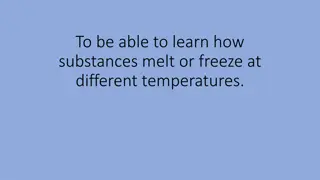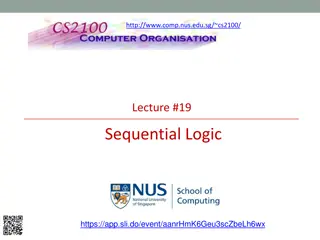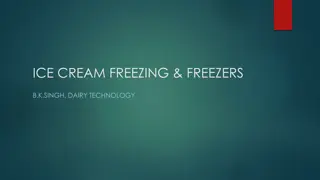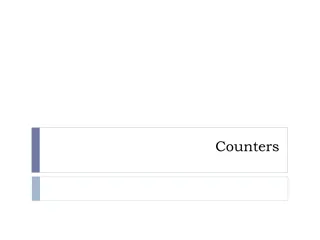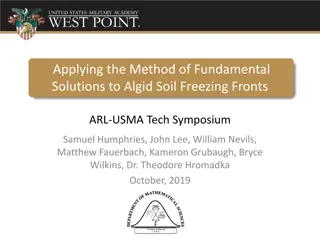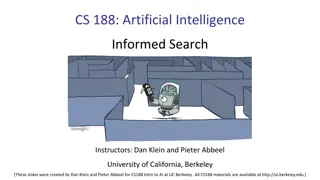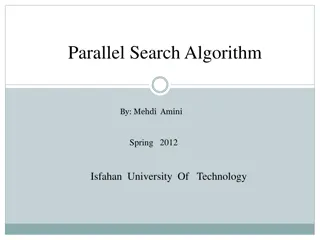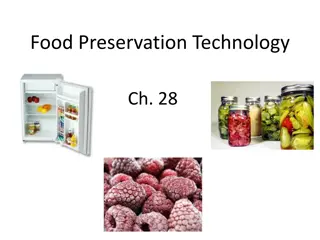Sequential Search with Offer Freezing: Theory and Experimental Evidence
This paper explores the concept of offer freezing in sequential search scenarios, particularly in the context of airline ticket pricing. A theoretical model is constructed to analyze the implications of price freezing options, followed by an experimental evaluation of the model's predictions. The study aims to understand individual decision-making behavior and assess the impact of deviations from optimal choices.
Download Presentation

Please find below an Image/Link to download the presentation.
The content on the website is provided AS IS for your information and personal use only. It may not be sold, licensed, or shared on other websites without obtaining consent from the author.If you encounter any issues during the download, it is possible that the publisher has removed the file from their server.
You are allowed to download the files provided on this website for personal or commercial use, subject to the condition that they are used lawfully. All files are the property of their respective owners.
The content on the website is provided AS IS for your information and personal use only. It may not be sold, licensed, or shared on other websites without obtaining consent from the author.
E N D
Presentation Transcript
Sequential Search with Offer Freezing: Theory and Experimental Evidence Emanuel Marcu and Charles Noussair Tilburg University and University of Arizona November 2022 Presentation prepared for the Tokyo University seminar series
Options to Freeze Prices Many airlines have begun offering an opportunity for travelers to freeze ticket prices before committing to a purchase. United Airlines offers an option, called Farelock, to freeze a price for one week for a fee of between 5 - 10 US dollars. KLM offers similar possibilities to lock a fare in for 14 days for 10 15 Euro. The mortgage and hotel markets have similar features. Locking in interest rates and free cancelation of reservations. The effect of this option to freeze has not yet been analysed by economists. The focus here is on the economics of price freeze options (not on modeling the airline industry in particular).
What we do in this paper We construct a theoretical model to evaluate the consequences of a price freezing option. Model assumes a sequential search structure and a finite horizon. Airline ticket purchases are a good example of sequential search over a finite horizon. We then conduct an experiment to evaluate the predictions of the model. The hypotheses for the experiment emerge from the model. Two environments are considered, No Recall and Imperfect Recall. I will focus on the case of No Recall of previous offers in this talk.
What is the point of doing a laboratory experiment here? We would like to know how difficult it is for individuals to make optimal decisions in this setting. Experiments have shown that in many settings, individuals are able to perform close to optimally. In other settings, people are overcome with decision biases. We would like to know what kind of situation this is. How costly should we expect any deviations from the optimum to be?
Theoretical model with No Freezing Uses a sequential search model structure (McCall, 1970, Landsberger and Peled, 1977; Karni and Schwartz, 1977) A potential buyer of a good has a fixed valuation v for the item. There are T stages. In each stage, buyer receives one price offer pt, less than her value. Price offers ptare i.i.d draws from a distribution F(p). At each stage t, she can choose to (a) accept or (b) reject the offer. If she accepts an offer pt, she receives payoff v pt. There is a cost of c of drawing an additional offer in the next stage. Buyer is risk neutral. There is no recall of prior offers.
The optimal decision rule: a reservation price rule If no freeze option is available, the optimal strategy is a reservation price rule (RR). Compare expected payoff from acceptance and rejection at each stage. Accept all offers below some threshold p (t), reject all of those above p (t) is the point at which a player is indifferent between accepting and rejecting. Threshold increasing in t. You get less picky over time. In the last stage, accept any offer.
Payment Consumer becomes less picky over time and threshold increases p (1) p (T-1) Price Price Offered
Adding a freeze option Suppose we add a third option, to freeze the offer received in any stage. An offer that is frozen can be recalled and accepted in any later stage until T. Only one offer can be frozen. Offers cannot be unfrozen. There is a fee of f to freeze an offer Freezing an offer is, in effect, the purchase of an outside option
First, consider an exogenous outside option To build up the model, we first consider the case of an outside option that is exogenous At each stage t, need to compare (a) payment if accepting current offer, pt (b) payment if taking outside option, k and (c) expected payment from rejection and continuation . is the expected payment the searcher makes. Choice at time t is made to minimize this.
A couple of definitions: The expected rejection payment: Let be the expected amount paid if offer of stage t is rejected when there is an outside option. To get the next stage s offer, agent must pay cost c.
p* Let p* be the price that makes an individual indifferent between (i) accepting the current best offer, min{pt, k} and (ii) waiting exactly one more stage and accepting the best offer available in the next stage min{pt+1, k}. It is the price that makes you indifferent between accepting or rejecting in period T 1.
Acceptance of the outside option If the outside option k p*, one would never reject at T - 1. You either accept current offer or outside option. Because you would never reject at T 1, at T 2 it is as if there is only one stage remaining. So you never reject at T 2. This unravels to stage 1. If you never reject at t = 1, you either accept current offer or take the outside option at t = 1. If the outside option k > p*, you always want to either accept the current offer or reject it and continue searching for at least one more stage. The only time that you could choose the outside option is in stage T and only if it is lower than the current offer of that stage.
Optimal strategy under endogenous freezing Now suppose that you can pay a fee of f to freeze the current offer pt The optimal strategy is a reservation/double reservation price rule (RR-DRR). DRR strategy: Accept offers below at, freeze those between at and bt, and reject those above bt, with at bt. If horizon is long enough, in early stages at = bt (RR). Either accept or reject. In late stages at < bt(DRR). Accepting, freezing, or rejecting are all possible.
Example of aDRR (Double Reservation Price Rule) In later stages, as the rejection payment increases, it becomes optimal to freeze some offers. If accept pt Payment If freeze pt Offers below at are accepted, those between at and bt are frozen, and those above bt are rejected. If reject Offer at stage t
Formal statement of optimal policy Single-threshold strategy always followed by double threshold strategy. There is always some positive probability of freezing by stage T 1. If the horizon is sufficiently long, there will be stages at the outset where it is optimal not to freeze any offer. Freezing more likely over time until stage T 1. Both thresholds at and btincrease over time. Get less picky over time with both acceptances and freezing. Frozen offers, if accepted, are only accepted in period T.
Previous work Kahan, Rapoport and Lyle (1967): Varied distributions of offers and observed that this did not have a strong effect on optimality of decisions. Subjects tested in groups searched longer. Rapoport and Tversky (1970): Decisions close to optimal with some early stopping. Schotter and Braunstein (1981): Found behavior close to optimal in indefinite horizon, differences between risk averse and risk neutral incentives. Cox and Oaxaca (1989): Finite horizon, behavior close to optimal. Cox and Oaxaca (1992): Reservation wage behavior consistent with risk aversion. Gong and Ramachandran (2007): Shape of payoff function is important. Weng et al. (2009): Claim that undersearching is a result of regret and is affected by feedback. Zwick et al., (2003): find undersearching in a secretary problem.
The experiment Subjects were in the role of sellers (as in a labor market setting) rather than buyers. Each round consisted of T stages. Conducted in terms of an experimental currency (70 ECU = $1) Offer were drawn from U[0, 1000] in each stage Search cost c = 10. 180 offer sequences (rounds) in each session
Treatments: Varied time horizon and freeze costs T {4, 10}, Short (T4) or Long (T10) Horizon f { , 10, 40}, No Freezing allowed (NF), Low Freeze Fee (LF), High Freeze Fee (HF) T was varied between subject, f was varied within subject 60 rounds under each of Low Fee (LF), High Fee(HF) and No Freezing (NF), order counterbalanced.
Implementation 177 subjects Conducted at the Economic Science Laboratory at the University of Arizona Used z-tree (Fischbacher, 2007) Two price lists to measure risk aversion administered before main task (simple price list, and a Holt-Laury (2002) task) 1 of 182 total tasks counted toward earnings Forced two-minute breaks after 60 and 120 sequences Required to spend at least 60 minutes on the task. Perturbed, but nearly identical, sequences used in each of the three 60-period blocks
Optimal decisions in treatment with T = 10 and no freezing Black = Accept White = Reject Offer High offers are accepted with the reservation price declining over time. Predictions for T = 4 are those from period T 3 on. In period T, accept all offers. Time
Optimal decisions in treatment with T = 10 and no freezing Black = Accept White = Reject Offer High offers are accepted with the reservation price declining over time. Predictions for T = 4 are those from period T 3 on. In period T, accept all offers. Time
Offer Optimal decisions: T = 10, Freezing option available Black = Accept Gray = Freeze White = Reject Time Freezing is increasingly likely over time, and when the fee is lower. Offer Acceptance is increasingly likely over time, and when the freezing fee is higher Rejection less likely over time, and when fee is lower Time
Predictions: Search length, Freezing Usage Search length is increased by lower freeze costs, and longer horizon. Freezing usage is increased by lower freeze costs, and a shorter horizon. Earnings are increased by availability of freezing (if horizon is short), lower freeze costs and a longer horizon.
Hypotheses H1: Search length is shorter when f is greater and T is smaller. H2: Freezing is less frequent when f is greater and T is greater. The second part of the prediction is a stringent test of the model. H3: Individuals employ the optimal RR-DRR strategy These are all predictions of the model.
Results: Average search length, by treatment Search length longer with: - Possibility of freezing (H1 +) - Lower Freeze Fee (H1 +) - Longer Horizon (H1 +) Search length shorter than predicted except for T4NF, T4HF
Freezing is more common when: - Freezing is cheaper (H2 +) - The horizon is short (H2 +) Freezing usage and acceptance of frozen offers Less freezing than predicted by model Decisions to Freeze and Accept Frozen Offers Those frozen offers that are accepted tend to be accepted in the last stage in T4, but not T10. 80 70 72 60 Percentage of searches 50 45 40 42 39 30 33 26 20 20 10 12 10 9 3 1 1 6 1 2 0 Predicted incidence Actual incidence Frozen and Accepted in Last Stage Frozen and Accepted Before Last Stage T4LF T10LF T4HF T10HF
Earnings are greater when freezing is available than in its absence when horizon is short. Earnings Earnings are greater when freezing is cheaper when the horizon is short. No effect of freeze cost when horizon is long. Earnings are greater when the horizon is long than when it is short. Earnings are quite close to the optimum
Do people use RR strategies? No Freezing treatments, stage 1 behavior Strong differences between behavior above and below optimal threshold. Modestly more acceptances than predicted under T = 10. Fitted threshold = 666 Theoretical prediction = 675 Fitted threshold = 771, Theoretical prediction = 806 Fitted function l{x;m,k) = [1 + exp(-k(x m))]-1m = midpoint, k = curvature
Low Freeze Fee treatments, stage 1 behavior Fitted acc. threshold = 808, pred = 846 Fitted freeze threshold = 770, pred = 743 Fitted acc threshold = 768, pred = 834 Fitted freeze threshold = 512, pred = 502 Fitted function l{x;m,k) = [1 + exp(-k(x m))]-1m = midpoint, k = curvature Acceptance behavior: observed threshold lower than predicted. Freezing peaks in predicted range.
High Freeze Fee treatments: stage 1 behavior Ac Fitted acc. threshold = 745, pred = 765 Fitted freez. threshold = 591, pred = 602 Fitted function l{x;m,k) = [1 + exp(-k(x m))]-1m = midpoint, k = curvature Fitted acc threshold = 782, pred = 811 No freezing predicted Some degree of undersearching. Acceptance threshold is modestly lower than predicted. Estimated freezing threshold as predicted. However, considerable failure to freeze when optimal.
Evaluation of Hypotheses H1: Search length is shorter when f is greater and T is smaller. STRONGLY SUPPORTED H2: Freezing is less frequent when f is greater and T is greater. STRONGLY SUPPORTED H3: Individuals employ the optimal RR-DRR strategy MIXED SUPPORT
ALTERNATIVE EXPLANATIONS FOR UNDERSEARCHING We evaluate four potential explanations that have been proposed to explain undersearching when freezing is not possible
Alternative explanations: Regret 1) Regret (Loomes and Sugden, 1989; Weng 2009) Lowers value of accepting, freezing, and rejecting. This predicts oversearching, so we do not consider it further. Why? Individuals experience regret from accepting prices worse than those that they rejected previously, making them less willing to sell.
Alternative Explanations: Cognitive Acquisition Cost 2) Cognitive acquisition cost, Insufficient backward induction (Gabaix et al., 2006) Three versions: a) Act as if you are in stage t+1 when really in stage t b) Act as if you are in stage t+2 when really in stage t c) Act as if you are in stage T 1. All of these specifications predict overfreezing, which we do not observe.
Alternative explanations: Sunk Cost Fallacy 3) Sunk Cost Fallacy (SCF) model (Kogut, 1990) Use total cost instead of marginal cost in calculation of expected rejection payment This can capture a situation in which individuals are eager to terminate long searches. Predicts undersearching
Alternative Explanation: Risk Aversion 4) Risk aversion (Cox and Oaxaca, 1989) Typical estimate for the CRRA functional form in experimental work is .3 (Holt and Laury, 2002; Harrison and Rutstrom (2008), Noussair et al. (2014)). Also predicts undersearching.
Agreement of decision with Risk Neutral Optimal model and alternative models in instances with competing predictions.
Summary of results: Search length The length of search is increasing in the horizon length, and decreasing in the freezing fee. These effects are predicted by the model Suggests that sellers introducing a freezing option will make customers search longer. Lower freezing fees will make them search even longer. This is not good for efficiency since there is a cost (deadweight loss) associated with greater searching.
Summary of results: Use of the freezing option The use of freezing decreases in the freezing fee and the horizon length Most acceptances of frozen offers occur in the last period. These effects are predicted by the model. However, overall, there is less freezing than predicted Suggests that uptake on sellers freezing options will be less than predicted Loss aversion?
Summary of Results: Payoffs/Earnings Earnings are only slightly less than along the optimal path. Important because it reveals that this type of decision problem is not very difficult for people. Earnings are greater when the horizon is longer When the horizon is short, earnings are higher the lower the freezing fee. Overall, consumers can be expected to make good decisions in a market with price freezing.
Summary of Results: Payoffs/Earnings Earnings for the other party (airlines): Introduction of a freeze option lengthens search. It increases searching party s earnings, despite the fact that they pay more in search cost. This means that the other side of the market is worse off under a freeze option. Airlines might find that they are worse off with the freeze option. They might lose money on each individual customer, but make it up with market share. They might have no choice. Freezing might be another margin which they might have to compete on.


